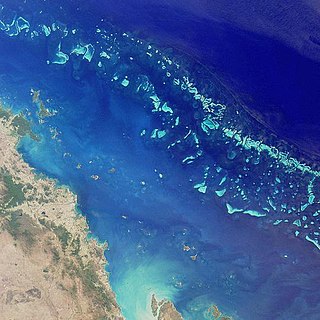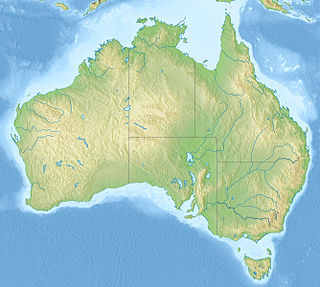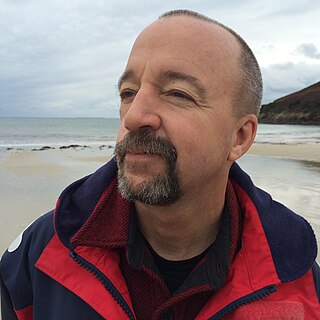Related Research Articles

Natural resources are resources that exist without any actions of humankind. This includes all valued characteristics such as magnetic, gravitational, electrical properties and forces, etc. On Earth, it includes sunlight, atmosphere, water, land along with all vegetation, crops, and animal life that naturally subsists upon or within the previously identified characteristics and substances.

The United Nations Environment Programme is responsible for coordinating the UN's environmental activities and assisting developing countries in implementing environmentally sound policies and practices.

The Great Barrier Reef is the world's largest coral reef system composed of over 2,900 individual reefs and 900 islands stretching for over 2,300 kilometres (1,400 mi) over an area of approximately 344,400 square kilometres (133,000 sq mi). The reef is located in the Coral Sea, off the coast of Queensland, Australia. The Great Barrier Reef can be seen from outer space and is the world's biggest single structure made by living organisms. This reef structure is composed of and built by billions of tiny organisms, known as coral polyps. It supports a wide diversity of life and was selected as a World Heritage Site in 1981. CNN labelled it one of the seven natural wonders of the world. The Queensland National Trust named it a state icon of Queensland.

The International Union for Conservation of Nature is an international organization working in the field of nature conservation and sustainable use of natural resources. It is involved in data gathering and analysis, research, field projects, advocacy, and education. IUCN's mission is to "influence, encourage and assist societies throughout the world to conserve nature and to ensure that any use of natural resources is equitable and ecologically sustainable".

Conservation in Australia is an issue of state and federal policy. Australia is one of the most biologically diverse countries in the world, with a large portion of species endemic to Australia. Preserving this wealth of biodiversity is important for future generations.

Marine debris, also known as marine litter, is human-created waste that has deliberately or accidentally been released in a sea or ocean. Floating oceanic debris tends to accumulate at the center of gyres and on coastlines, frequently washing aground, when it is known as beach litter or tidewrack. Deliberate disposal of wastes at sea is called ocean dumping. Naturally occurring debris, such as driftwood, are also present.

Wildcoast is an international non-profit environmental organization that conserve coastal and marine ecosystem and wildlife.

The green sea turtle, also known as the green turtle, black (sea) turtle or Pacific green turtle, is a species of large sea turtle of the family Cheloniidae. It is the only species in the genus Chelonia. Its range extends throughout tropical and subtropical seas around the world, with two distinct populations in the Atlantic and Pacific Oceans, but it is also found in the Indian Ocean. The common name refers to the usually green fat found beneath its carapace, not to the color of its carapace, which is olive to black.

The Gulf of Mannar Marine National Park is a protected area of India consisting of 21 small islands (islets) and adjacent coral reefs in the Gulf of Mannar in the Indian Ocean. It lies 1 to 10 km away from the east coast of Tamil Nadu, India for 160 km between Thoothukudi (Tuticorin) and Dhanushkodi. It is the core area of the Gulf of Mannar Biosphere Reserve which includes a 10 km buffer zone around the park, including the populated coastal area. The park has a high diversity of plants and animals in its marine, intertidal and near shore habitats. Public access inside the park is limited to glass-bottom boat rides.

The Ningaloo Coast is a World Heritage Site located in the north west coastal region of Western Australia. The 705,015-hectare (1,742,130-acre) heritage-listed area is located approximately 1,200 kilometres (750 mi) north of Perth, along the East Indian Ocean. The distinctive Ningaloo Reef that fringes the Ningaloo Coast is 260 kilometres (160 mi) long and is Australia's largest fringing coral reef and the only large reef positioned very close to a landmass.

Environmental issues in Australia describes a number of environmental issues which affect the environment of Australia. There are a range of such issues, some of the relating to conservation in Australia while others, for example the deteriorating state of Murray-Darling Basin, have a direct and serious effect on human land use and the economy.

The Jiyeh Power Station oil spill is an environmental disaster caused by the release of heavy fuel oil into the eastern Mediterranean after storage tanks at the thermal power station in Jiyeh, Lebanon, 30 km (19 mi) south of Beirut, were bombed by the Israeli Air force on July 14 and July 15, 2006 during the 2006 Israel-Lebanon conflict. The plant's damaged tanks leaked up to 30,000 tonnes of oil into the eastern Mediterranean Sea, A 10 km wide oil slick covered 170 km of coastline, and threatened Turkey and Cyprus. The slick killed fish, threatened the habitat of endangered green sea turtles, and potentially increased the risk of cancer.

Papua New Guinea together with the West Papua region of Indonesia make up a major tropical wilderness area that still contains 5% of the original and untouched tropical high-biodiversity terrestrial ecosystems. PNG in itself contains over 5% of the world's biodiversity in less than 1% of the world's total land area. The flora of New Guinea is unique because it has two sources of origin. The Gondwana flora from the south and flora with Asian origin from the west, as a result New Guinea shares major family and genera with Australia and the East Asia, but is rich in local endemic species. The endemicity is a result of mountainous isolation, topographic and soil habitat heterogeneity, high forest disturbance rates and abundant aseasonal rainfall year-round. PNG boasts some 15-21,000 higher plants, 3,000 species of orchids, 800 species of coral, 600 species of fish, 250 species of mammals and 760 species of birds and 8 species of tree-kangaroos out of which 84 genera of animals are endemic. Ecosystems range from lowland forests to montane forests, alpine flora down to coastal areas which contains some of the most extensive pristine mangrove areas in the world. Much of this biodiversity has remained intact for thousands of years because the ruggedness of the terrain made the interior lands inaccessible; furthermore low population density and restrictions on the effectiveness of traditional tools, ensured that these biodiversity was never overexploited.

Ocean Conservancy is a nonprofit environmental advocacy group based in Washington, D.C., United States. The organization helps formulate ocean policy at the federal and state government levels based on peer reviewed science.

The Australian environment ranges from virtually pristine Antarctic territory and rainforests to degraded industrial areas of major cities. Forty distinct ecoregions have been identified across the Australian mainland and islands.

Marine conservation activism is the efforts of non-governmental organizations and individuals to bring about social and political change in the area of marine conservation. Marine conservation is properly conceived as a set of management strategies for the protection and preservation of ecosystems in oceans and seas. Activists raise public awareness and support for conservation, while pushing governments and corporations to practice sound ocean management, create conservation policy, and enforce existing laws and policy through effective regulation. There are many different kinds of organizations and agencies that work toward these common goals. They all are a part of the growing movement that is ocean conservation. These organizations fight for many causes including stopping pollution, overfishing, whaling and by-catching, and supporting marine protected areas.

Eritrea, officially the State of Eritrea, is a country in Eastern Africa, with its capital at Asmara. It is bordered by Ethiopia in the south, Sudan in the west, and Djibouti in the southeast. The northeastern and eastern parts of Eritrea have an extensive coastline along the Red Sea. The nation has a total area of approximately 117,600 km2 (45,406 sq mi), and includes the Dahlak Archipelago and several of the Hanish Islands.

Watamu Marine National Park and Reserve is located in Kenya. Established in 1968, it was one of Kenya's first marine parks. It is located about 90 miles (140 km) north of Mombasa, Kenya's second largest city. Its coral gardens are merely 300 metres (980 ft) from the shore and are home to approximately 600 species of fish, 110 species of stony coral and countless invertebrates, crustaceans and molluscs. Water temperature varies from 20 degrees Celsius to 30 degrees Celsius. The park was designated as a biosphere reserve in 1979.

Linwood Pendleton, an American environmental economist, is the World Wildlife Fund (WWF) Global Oceans Lead Scientist. He works across the WWF network and with partners to integrate science and research into ocean conservation strategy and initiatives. Since October 2014, Pendleton has served as International Chair in Marine Ecosystem Services at the Laboratory of Excellence and European Institute for Marine Studies. He is also a senior fellow at Duke's Nicholas Institute for Environmental Policy Solutions (NIEPS) and Adjunct Associate Professor at the Duke University Marine Laboratory, part of NIEPS. He previously served as the Director of Ocean and Coastal Policy for the Nicholas Institute (2009-2013) and was the founder of the Marine Ecosystem Services Partnership. Pendleton was the Acting Chief Economist for the National Oceanic and Atmospheric Administration (NOAA) from 2011-2013.
The Benguela Current Commission, or BCC, is a multi-sectoral inter-governmental, initiative of Angola, Namibia and South Africa. It promotes the sustainable management and protection of the Benguela Current Large Marine Ecosystem, or BCLME. The BCC was established in January 2007 through the signing of an Interim Agreement between the governments of Angola, Namibia and South Africa. Then, on 18 March 2013, the three governments signed the Benguela Current Convention, an environmental treaty that entrenches the Benguela Current Commission as a permanent inter-governmental organization.
References
- 1 2 "What did Canadian mining executives know about possible human rights violations in Eritrea?". CBC. January 22, 2019.
- ↑ Swift, Richard (December 1992). "A traveler's notebook". New Internationalist. Archived from the original on 2006-11-04. Retrieved 2006-10-20.
- ↑ "Mangroves: Salt-resistant allies in the fight against hunger and poverty" (PDF). OPEC Fund Newsletter. 2003. Archived from the original (PDF) on 2007-10-06. Retrieved 2006-10-20.
- ↑ "Eritrea set to protect entire coast in world first". AFP. 2006-12-13. Archived from the original on 2007-09-26. Retrieved 2006-12-13.
- ↑ "National symposium on utilization of marine resources held here". Archived from the original on September 30, 2007. Retrieved 2006-12-13.
- ↑ Pilcher, Nicolas; Mahmud, Sammy; Howe, Steffan; Teclemariam, Yohannes; Weldeyohannes, Simon (2006). "An Update on Eritrea's Marine Turtle Programme and First Record of Olive Ridley Turtle Nesting in the Red Sea". Marine Turtle Newsletter. Retrieved 2006-12-13.